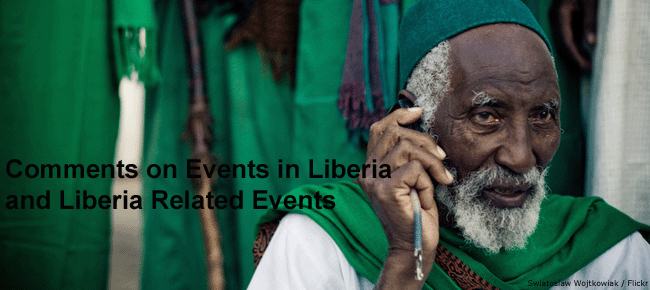Wednesday, June 4
Population – Part I:
The 2008 National Population and Housing Census
I am on vacation right now and enjoy making daily trips in the surroundings. The diversity of the Netherlands is astonishing and refreshing. It is a small country, one hundred miles from east to west, and at most two hundred miles from north to south. Yet, we live here – peacefully - with over 16 million people.
Compare that to Liberia, also a small country, but with an area of 43,000 square miles (about equal to that of Ohio or Louisiana) and a population of around 3 million people. The exact number will be known as soon as the results of the recently held Population Census will be published.
Upon my return from the daily trips, after the evening-meal, I usually go to my study and dive into my archives in an attempt to reorganise them. Or I re-arrange the books in my bookcase. Some days ago I stumbled upon a book which caught and held my attention. It was Merran Fraenkel’s ‘Tribe and Class in Monrovia’. I had read it many years ago, and vividly remembered it’s contents. It was one of the most informative books on Liberia, that is to say, Monrovia, and it became a standard work. However, the book was not appreciated by the ruling class. The author carried out her fieldwork in 1958/1959. In those days there was a great divide between Monrovia’s ‘upper class’ and the tribal people. Also, there was a separation between the five coastal counties and the hinterland, composed of three provinces. The coastal areas and hinterland were separated by lack of roads and other means of communication - even by different laws! This only changed in the 1960s.
The ruling ‘Americo-Liberians’ then numbered about 25,000; the great majority of the population was composed of members of about twenty tribes. On linguistic, cultural and historical grounds four groups could be distinguished: the Kru and the Grebo; the Bassa; the Vai and Gola; and the Kpelle and Loma. Mandingoes, from the Mande-speaking regions north of Liberia, and Fanti, from the Gold Coast, nowadays Ghana, have settled in Liberia in more recent times.
This mosaic of peoples still exists, fifty years after publication of Merran Fraenkel’s book. Half a century has since elapsed; many changes took place. The investment boom of the 1960s brought some, much needed, modernisation but not the even more needed integration of the various components of the population. President Tubman’s Unification Policy – aiming at uniting the Liberian people - was continued by his successor Tolbert, but came to an end in the 1980s – the Doe era. After the devastating civil war was over, the economy was in ruins and the Liberian people more divided than ever.
Liberia’s first National Population and Housing Census since 1984 was launched in June 2007. It cost about US $ 6 million to conduct the census, which was held in 2008. During the operation, people were hostile to the census workers, removing the chalk X written on their huts and houses to mark and distinguish them from households not yet covered. The scars of the civil war were too fresh.
The census data are needed for planning purposes. To recover from the war. To rebuild the economy. As such, the census is an indispensable instrument for planners and politicians. The census results are eagerly awaited; they may become available before the end of this year.
But counting people is not the same as uniting people.
To be continued.
Part II will focus on The Truth and Reconciliation Commission of Liberia. Staggering confessions continue to emerge at the public hearings of the Truth and Reconciliation Commission (TRC). Can Liberians ever come to terms with the past?
Recommended reading:
Merran Fraenkel, ‘Tribe and Class in Monrovia’ (Oxford University Press, London; first published 1964; reprinted 1965 and 1970).
2008/06/04
Subscribe to:
Post Comments (Atom)


No comments:
Post a Comment